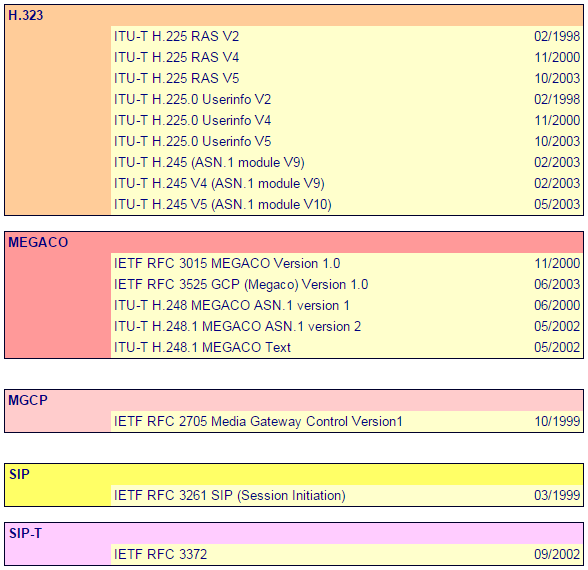Standardized
|
Proprietary
|
H.323
|
Skype
|
SIP
|
Cisco System (Skinny)
|
H.248
|
Asterisk (IAX, open source), etc
|
Proprietary Protocols
- have restricted innovation (smaller users/developers community, narrowed vision, solving smaller issues)
- restrict the set of available functionalities because of interoperability (developing gateways to every protocol take too long)
Standardized Protocols
Audio/Video Transport
|
Signaling
|
|
ITU-T
|
RTP/RTCP
|
H.323
H.248
|
IETF
|
RTP/RTCP
|
SIP
MGCP
MEGACO
|
Standard protocols: Media Transport
- Protocols designed to deliver real time data to the remote entities:
- RTP (Real Time Protocol: IETF RFC 3550, July 2003)
- Provides end-to-end network transport functions suitable for applications transmitting real time data, such as audio, video
- RTCP (Real Time Control Protocol: IETF RFC 3550, July 2003)
- Control protocol to allow monitoring of the data delivery, and to provide minimal control and identification functionalities
- RTP/RTCP are always sent on top of UDP (User Datagram Protocol) on IP-based networks
Codec (G.7xx, GSM, iLBC, Speex, H.26x)
|
RTCP
|
RTP
|
|
UDP
|
|
Network Protocol and Network Interface
|
|
Standard Protocols: Call Signaling
- Before audio or video media can flow using RTP/RTCP between two entities
- need of finding the remote device and to negotiate the means by which media will flow between the two devices
- The protocols that are central to this process are referred to as call signaling protocols, the two standardized are
- H.323 (ITU-T Study Group 16, version 5, 2003)
- SIP (Session Initiation Protocol, original IETF RFC 2543, updated by IETF RFC 3261, June 2002)
A little
bit of story:
- H.323 and SIP both have their origins in 1995
- H.323 enjoyed the first commercial success due to the fact that ITU quickly published the first standard in early 1996
- SIP progressed much more slowly in the IETF with the first recognized "standard" published later in 1999
- SIP was revised over the years and re-published in 2002 as RFC 3261, which is the currently recognized standard for SIP
- These delays in the standards process resulted in delays in market adoption of the SIP protocol
- Today H.323 is still having the bigger commercial market share but the trend is toward SIP
- SIP was chosen as the official protocol by the 3GPP partnership alliance for the UMTS IMS (IP Multimedia subsystem) (SIP is the official protocol for IP-based call signaling in UMTS
- first application: Push To Talk (PTT)
Standard Protocols: Additional Signaling
- MGCP (Media Gateway Control Protocol: IETF RFC 3661, was RFC 3435, was RFC 2705)
- control protocol for controlling Media Gateways (MG) from external call control elements called Media Gateway Controllers (MGC)
- MEGACO (MEdia GAteway COntrol protocol)
- This version of the protocol is the next generation of MGCP
- Joint effort of the IETF MEGACO working group and the ITU Study Group 16
- ETF refer to the protocol as “MEGACO” (RFC 3525, was RFC 3015, was RFC 2885)
- ITU refers to it as H.248
- Currently is under discussion the MEGACO/H.248 version 2
- Summarizing: they are not IP Telephony protocols of their own!
- they are addressing complementary topics related to media control on gateways (only legacy voice features)
- need to use them to achieve IP Telephony
Overview of Protocol
H.323
H.323 was
the first of the four voice signaling protocols and definitely has maturity on
its side. The International Telecommunication Union, Telecommunication
Standardization Sector (ITU-T) originally created H.323 to allow simultaneous
voice, video, and data to transmit across ISDN connections. It has since been
adapted to work over LAN environments.
Session Initiation Protocol (SIP)
SIP is
often called the “next
generation” of H.323. Developed
by the Internet Engineering Task Force (IETF), SIP is a much more lightweight
and scalable protocol than H.323. While support for SIP is widespread, it is an
evolving standard that does not currently support many of the advanced features
232 CCNA Voice Official Exam Certification Guide of VoIP networks. As SIP
becomes more mature and robust, it is poised to become the primary VoIP
signaling standard used worldwide (similar to the way data networks use TCP/IP
today).
Media Gateway Control Protocol (MGCP)
MGCP is the
first true “client/server” VoIP signaling protocol. If you are using MGCP, you
will perform the vast majority of your gateway configuration from a centralized
system known as a call agent. Because this is a newer IETF standard, it is not
as widely supported as H.323 or SIP.
Skinny Client Control Protocol (SCCP)
SCCP is the
only Cisco-proprietary VoIP protocol currently in use. Although SCCP is not specifically
designed for gateway signaling and control, a limited number of Cisco gateways
do support it. The primary goal of SCCP is to provide a signaling protocol
between the Cisco Unified Communications Manager and Cisco IP phones. Similar
to MGCP, the SCCP devices report every action to the Communications Manager
server, which then responds with the action the device should take.
RTP
The
Real-time Transport Protocol (RTP) provides end-to-end network transport
functions suitable for applications transmitting real-time data such as audio,
video or simulation data, over multicast or unicast network services. RTP does
not address resource reservation and does not guarantee quality-of-service for
real-time services. The data transport is augmented by a control protocol
(RTCP) to allow monitoring of the data delivery in a manner scalable to large
multicast networks, and to provide minimal control and identification
functionality. RTP and RTCP are designed to be independent of the underlying
transport and network layers. The protocol supports the use of RTP-level
translators and mixers.
RTCP
The RTP
Control Protocol (RTCP) is based on the periodic transmission of control
packets to all participants in the session, using the same distribution
mechanism as the data packets. The underlying protocol must provide
multiplexing of the data and control packets, for example using separate port
numbers with UDP.
Specification
 |
| Specifications |
----






No comments:
Post a Comment